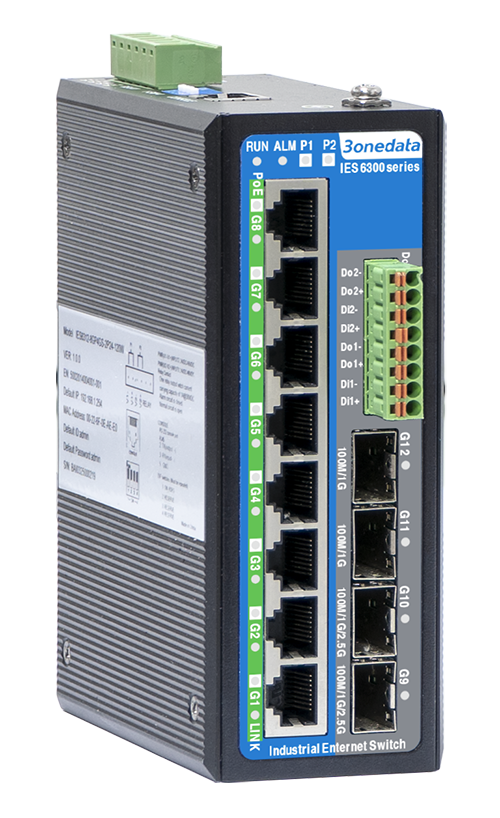

| Standard & Protocol | IEEE 802.3 for 10Base-T IEEE 802.3u for 100Base-TX IEEE 802.3ab for 1000Base-T IEEE 802.3z for 1000Base-X IEEE 802.3x for Flow Control IEEE 802.1D for Spanning Tree Protocol IEEE 802.1w for Rapid Spanning Tree Protocol IEEE 802.1s for Multiple Spanning Tree Protocol ITU-T G.8032 for ERPS IEEE 802.1Q for VLAN IEEE 802.1p for CoS IEEE 802.1AB for LLDP IEEE 802.3ad for LACP IEEE 802.3af for PoE IEEE 802.3at for PoE+ |
| Management | SNMP v1/v2c/v3 Centralized Management of Equipment, QoS, PoE, DHCP Server, DHCP Snooping, DHCP Relay, Static MAC Address, LLDP, Storm Suppression, User Password, Login Method, File Management, Log Management, Port Statistics |
| Security | User Privilege Classification, Authentication Method Configuration, SSH Configuration, HTTPS Configuration, Access Control, SNMP, RMON, Port Limit Control, Port Security, NAS, ACL, Ethernet Services, RADIUS Server Authentication, TACACS + Server Authentication, Port Alarm, DC Power Supply Alarm, IO Alarm, Loop Protection |
| Switch Function | 802.1Q VLAN, Static Aggregation, LACP |
| Unicast / Multicast | IGMP Snooping, Unicast MAC |
| Redundancy Technology | Ring, STP/RSTP/MSTP, ERPS |
| Troubleshooting | Ping, Cable Detection, DDMI, Port Mirroring |
| Time Management | NTP, Time Zone Configuration |
| PoE (optional) | The maximum power of PoE port: 30W The power supply pin of PoE: V+, V+, V-, V- correspond to Pin 1, 2, 3, 6 |
| Interface | Gigabit Copper Port: 10/100/1000Base-T(X), RJ45, Automatic Flow Control, Full/Half Duplex Mode, MDI/MDI-X Autotunning, optional PoE Gigabit SFP Slot : 100/1000Base-X self-adaption or forced mode, SFP slot 2.5G SFP Slot: 100/1000/2.5GBase-X self-adaption or forced mode SFP slot I/O port (optional): Support 2 inputs and 2 outputs, 8-pin 3.81mm pitch terminal blocks, support dry contact input, relay-type output Console port: CLI command line management port(RS-232), RJ45 Alarm Port: 6-pin 5.08mm pitch terminal blocks, relay occupies 2 pins and 1 relay alarm information output is supported, the current load capability is 1A@30VDC or 0.3A@125VAC |
| Indicator | Running indicator, alarm indicator, power supply indicator, interface indicator, PoE indicator (optional), I/O output indicator (optional), I/O input indicator (optional) |
| Switch Property | Transmission mode: store and forward MAC address: 8K Packet buffer size: 4Mbit Backplane bandwidth: 30G Switch time delay: <10μs |
| Power Supply | IES6300-8GT2GS2HS-2P48, IES6300-8GT2HS-2P48, IES6300-8GT2GS2HS-2DI2DO-2P48: Voltage range: 12~48VDC Connection method: 6-pin 5.08mm pitch terminal blocks (includes 4-pin power supply) Power supply quantity: dual power supply redundancy backup Connection protection: non-polarity Overcurrent protection: 3A IES6300-8GP2GS2HS-2P24-120W, IES6300-8GP2HS-2P24-120W: Power supply range: 24VDC PoE Connection method: 6-pin 5.08mm pitch terminal blocks (includes 4-pin power supply) Power supply quantity: dual power supply redundancy backup Connection protection: anti-reverse connection Overcurrent protection: 12A IES6300-8GP2GS2HS-2P48-240W, IES6300-8GP2HS-2P48-240W, IES6300-8GP2GS2HS-2DI2DO-2P48-240W: Power input: 48VDC PoE Connection method: 6-pin 5.08mm pitch terminal blocks (includes 4-pin power supply) Power supply quantity: dual power supply redundancy backup Connection protection: anti-reverse connection Overcurrent protection: 5A IES6300-8GP2GS2HS-P220, IES6300-8GP2HS-P220: Power input: 220VAC/DC Connection method: 6-pin 5.08mm pitch terminal blocks (includes 4-pin power supply) |
| Power Consumption | IES6300-8GT2GS2HS-2P48, IES6300-8GT2GS2HS-2DI2DO-2P48: No-load: ≤ 5.76W@48VDC Full-load: ≤12W@48VDC IES6300-8GT2GS2HS-2P48-240W, IES6300-8GT2GS2HS-2P24-120W, IES6300-8GP2GS2HS-2DI2DO-2P48-240W: No-load: ≤ 5.76W@48VDC Full-load: ≤ 132W@24VDC (with 120W PoE load) ≤ 252W@48VDC (with 240W PoE Load) |
| Working Environment | Operating temperature: -40~75℃ Storage temperature:-40~85℃ Relative humidity: 5%~95% (no condensation) |
| Physical Characteristic | Housing: IP40 protection, metal Installation: DIN-Rail or wall mounting Weight: ≤ 0.78kg Dimension (W x H x D): 53mm×138mm×110mm |
| Industrial Standard | IEC 61000-4-2 (ESD, electrostatic discharge), Level 3 IEC 61000-4-4 (EFT, electrical fast transient pulses), Level 3 IEC 61000-4-5 (Surge), Level 3 Shock: IEC 60068-2-27 Free fall: IEC 60068-2-32 Vibration: IEC 60068-2-6 |
| Authentication | CE, FCC, RoHS |
| Warranty | 5 years |
| Available Models | Gigabit RJ45 LAN Port | SFP Slot | I/O Port | PoE Power | Power Supply | |||
| Non-PoE | PoE | Gigabit | 2.5G | Input Range | Quantity | |||
| IES6300-8GT2GS2HS-2P48 | 8 | — | 2 | 2 | — | — | 12~48VDC | 2 |
| IES6300-8GP2GS2HS-2P24-120W | — | 8 | 2 | 2 | — | 120W | 24VDC | 2 |
| IES6300-8GP2GS2HS-2P48-240W | — | 8 | 2 | 2 | — | 240W | 48VDC | 2 |
| IES6300-8GT2GS2HS-P220 | 8 | — | 2 | 2 | — | — | 220VAC/DC | 1 |
| IES6300-8GT2HS-2P48 | 8 | — | — | 2 | — | — | 12~48VDC | 2 |
| IES6300-8GP2HS-2P24-120W | — | 8 | — | 2 | — | 120W | 24VDC | 2 |
| IES6300-8GP2HS-2P48-240W | — | 8 | — | 2 | — | 240W | 48VDC | 2 |
| IES6300-8GT2HS-P220 | 8 | — | — | 2 | — | — | 220VAC/DC | 1 |
| IES6300-8GT2GS2HS-2DI2DO-2P48 | 8 | — | 2 | 2 | 2 | — | 12~48VDC | 2 |
| IES6300-8GP2GS2HS-2DI2DO-2P48-240W | — | 8 | 2 | 2 | 2 | 240W | 48VDC | 2 |
